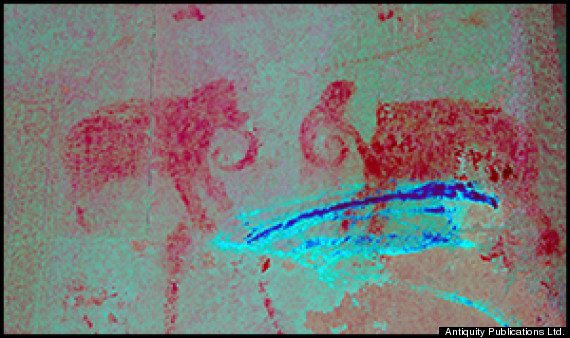Angkor Wat may be covered in graffiti—but don’t worry, it’s invisible. Built in the early 12th century, Cambodia’s architecturally iconic temple is known for its intricate carvings, some of them stretching nearly a kilometer in length.
But most archaeologists believe that parts of the temple were once painted as well. So when scientists noticed faint traces of red and black pigment on the walls of several rooms in Angkor Wat, they snapped pictures with a bright flash and used a tool called decorrelation stretch analysis to digitally enhance the images.
 Recent work reported here has identified an entirely new series of images consisting of paintings of boats, animals, deities and buildings. Difficult to see with the naked eye, these can be enhanced by digital photography and decorrelation stretch analysis, a technique recently used with great success in rock art studies. The paintings found at Angkor Wat seem to belong to a specific phase of the temple's history in the sixteenth century AD.
Recent work reported here has identified an entirely new series of images consisting of paintings of boats, animals, deities and buildings. Difficult to see with the naked eye, these can be enhanced by digital photography and decorrelation stretch analysis, a technique recently used with great success in rock art studies. The paintings found at Angkor Wat seem to belong to a specific phase of the temple's history in the sixteenth century AD.
Previously used to highlight subtle color differences in images of the martian landscape taken by NASA’s Opportunity rover, this type of analysis can reveal colors too faint or faded to be seen with the naked eye. When the researchers applied it to their photos of Angkor Wat, they found more than 200 images of boats, deities, buildings, and animals—like the elephants above (inset)—drawn on the walls throughout the temple, they report today in Antiquity.
Most of the paintings are haphazardly arranged and appear to be graffiti left by visitors after Angkor Wat was first abandoned in 1431. But one group of carefully drawn scenes, located in the highest tier of one of Angkor Wat’s towers, might be the remains of a 16th century restoration program, when the complex was transformed from a Hindu temple into a Buddhist shrine.
The previously lost images could give archaeologists new insight into this little-known period in Cambodia’s history.
This story has been provided by AAAS, the non-profit science society, and its international journal, Science.
